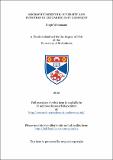Files in this item
Microphytobenthic diversity and function in estuarine soft sediment
Item metadata
| dc.contributor.advisor | Laland, Kevin N. | |
| dc.contributor.author | Weinmann, Birgit Ellen | |
| dc.coverage.spatial | 302 | en_US |
| dc.date.accessioned | 2013-06-11T10:44:13Z | |
| dc.date.available | 2013-06-11T10:44:13Z | |
| dc.date.issued | 2012 | |
| dc.identifier | uk.bl.ethos.574775 | |
| dc.identifier.uri | https://hdl.handle.net/10023/3664 | |
| dc.description.abstract | Corophium volutator (Pallas) fit the criteria of ‘ecosystem engineers’ as defined by Jones and colleagues (1994, 1997): they are widely distributed within and across North Atlantic estuaries, are often present in intertidal soft sediment in vast numbers, and build semi-permanent burrows in the sediment matrix, which they irrigate continuously. Previous studies have demonstrated that C. volutator burrowing and feeding not only modifies the sediment biogeochemistry but can also modify the overlying water biogeochemistry (during immersion). C. volutator activities have also been shown to be detrimental to microphytobenthic (MPB) biofilms in the immediate vicinity of the burrows. As MPB are the stabilizing force in the estuary, the decimation of biofilm destabilizes the habitat for all the organisms colonising it. However, several aspects of C. volutator ecology remain unclear. First, previous studies on the effect of C. volutator on local (within burrow proximity) MPB diversity have not presented a clear signal as to whether they increase or decrease biodiversity or established whether there is preferential survival amongst MPB taxa with certain cell shapes and sizes or lifestyles. Second, as it has been established that C. volutator have the potential to change the water column, it is possible for them to effect MPB populations remotely (outwith burrow proximity). It is therefore of interest to determine the effects they have, whether such an effect can be achieved within a tidal period, and whether these effects can change MPB biomass, behaviour or diversity over time. A series of controlled mesocosm experiments were carried out to quantify those effects of C. volutator on the water column which were likely to impact MPB survival, to determine whether those effects were specific to C. volutator or common to deposit‐feeding bioturbators, to determine to what degree they could be achieved within a single immersion period, and to separate the effects of C. volutator on MPB bulk (chlorophyll-a in top 5 mm) and photosynthesizing (fluorescing) biomass and diversity both ‘locally’ and ‘remotely’. The results of the first 3 experiments consistently showed that C. volutator substantially increased the resuspension of sediment to the overlying water column and that the resulting turbidity could reduce lightpenetration to the sediment by as much as 50% within one immersion period. Results of nutrient fluxes were less consistent and clear within and between experiments but there was some suggestion that increased bioirrigation increased inorganic nitrogen flux to the overlying water column in accordance with previous studies. The effects of C. volutator on local and remote MPB biomass (bulk and surface) and diversity varied between experiments but, broadly speaking: (1) bulk biomass was unaffected, reduced locally, or increased remotely; (2) surface biomass was reduced both locally and remotely; and (3) community diversity (Simpson’s diversity index) was consistently unaffected, both locally and remotely. Because increased water column turbidity is the most distinctive calling card of C. volutator but is only likely to affect the photosynthetically active (surface) MPB biomass during immersion, a controlled laboratory experiment was designed to examine the extent to which turbidity could influence MPB migratory behaviour and photosynthetic activity. MPB bulk migration was shown to be driven by sitespecific, entrained rhythms of light availability and spatial variation in light availability only drove micro‐cycling in the photic zone during the immersion period. So, in the absence of C. volutator, or any other turbidity producing phenomenon (deep water columns, high flow rates, physical disturbance, etc.), MPB will remain at the surface to photosynthesize during immersion and the productivity during this period is determined by total light intensity and exposure hours (or ‘light dose’). Therefore, the proximity and size of C. volutator populations to a site is likely to be influential in determining local productivity patterns of MPB. In addition, differences in MPB assemblage composition were shown to influence the biofilm productivity but what drives changes in MPB assemblage composition is still unclear and requires further investigation. | en_US |
| dc.language.iso | en | en_US |
| dc.publisher | University of St Andrews | |
| dc.subject.lcc | GC97.7W4 | |
| dc.subject.lcsh | Estuarine sediments | en_US |
| dc.subject.lcsh | Estuarine ecology | en_US |
| dc.subject.lcsh | Corophiidae--Ecology | en_US |
| dc.subject.lcsh | Corophiidae--Environmental enrichment | en_US |
| dc.subject.lcsh | Benthos--Ecology | en_US |
| dc.subject.lcsh | Benthos--Effects of turbidity on | en_US |
| dc.title | Microphytobenthic diversity and function in estuarine soft sediment | en_US |
| dc.type | Thesis | en_US |
| dc.type.qualificationlevel | Doctoral | en_US |
| dc.type.qualificationname | PhD Doctor of Philosophy | en_US |
| dc.publisher.institution | The University of St Andrews | en_US |
This item appears in the following Collection(s)
Items in the St Andrews Research Repository are protected by copyright, with all rights reserved, unless otherwise indicated.

